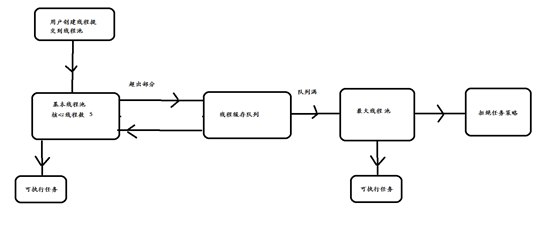java(线程池的创建方式,和线程池的原理)
1.为什么要使用线程池:
- 减少资源消耗,通过重复的使用已创建好的线程,避免了线程的频繁创建和销毁所造成的消耗
- 提高响应速度,当任务到达的时候,不需要再去创建,可以直接使用已经创建好的线程就能立即执行任务
- 提高线程的管理性,线程池可以统一管理线程的创建,销毁,分配,调优监控
2.使用线程池能解决什么问题
通过固定的几个线程为大量的操作服务,降低线程的频繁创建,销毁线程所需要消耗的时间,从而提高效应效率
3.线程池的创建方式
1.5版本通过Executors创建线程池
* @since 1.5 * @author Doug Lea */ public class Executors { /** * Creates a thread pool that reuses a fixed number of threads * operating off a shared unbounded queue. At any point, at most * {@code nThreads} threads will be active processing tasks. * If additional tasks are submitted when all threads are active, * they will wait in the queue until a thread is available. * If any thread terminates due to a failure during execution * prior to shutdown, a new one will take its place if needed to * execute subsequent tasks. The threads in the pool will exist * until it is explicitly {@link ExecutorService#shutdown shutdown}. * * @param nThreads the number of threads in the pool * @return the newly created thread pool * @throws IllegalArgumentException if {@code nThreads <= 0} */ public static ExecutorService newFixedThreadPool(int nThreads) { return new ThreadPoolExecutor(nThreads, nThreads, 0L, TimeUnit.MILLISECONDS, new LinkedBlockingQueue<Runnable>()); }
public static ExecutorService newFixedThreadPool(int nThreads) { return new ThreadPoolExecutor(nThreads, nThreads, 0L, TimeUnit.MILLISECONDS, new LinkedBlockingQueue<Runnable>()); }
查看:
ThreadPoolExecutor(nThreads, nThreads, 0L, TimeUnit.MILLISECONDS, new LinkedBlockingQueue<Runnable>());
public ThreadPoolExecutor(int corePoolSize, int maximumPoolSize, long keepAliveTime, TimeUnit unit, BlockingQueue<Runnable> workQueue) { this(corePoolSize, maximumPoolSize, keepAliveTime, unit, workQueue, Executors.defaultThreadFactory(), defaultHandler); }
corePoolSize: 核心池的大小。 当有任务来之后,就会创建一个线程去执行任务,当线程池中的线程数目达到corePoolSize后,就会把到达的任务放到缓存队列当中
maximumPoolSize: 线程池最大线程数,它表示在线程池中最多能创建多少个线程;
keepAliveTime: 表示线程没有任务执行时最多保持多久时间会终止。
unit: 参数keepAliveTime的时间单位,有7种取值,在TimeUnit类中有7种静态属性:
1.创建一个定长的线程池
package com.thread; import java.util.concurrent.ExecutorService; import java.util.concurrent.Executors; public class ExecutorsDemo { public static void main(String[] args) { ExecutorService newFixedThreadPool = Executors.newFixedThreadPool(5); for (int i = 0; i < 100; i++) { final int temp = i; newFixedThreadPool.execute(new Runnable() { @Override public void run() { System.out.println(Thread.currentThread().getName() + ",i:" + temp); } }); } } }
上面创建了一个线程池大小为5的线程池,所有的任务都将由这5条线程执行,超出线程会在队列等待 核心线程数==最大线程数
定长线程池的大小最好根据系统资源进行设置。如Runtime.getRuntime().availableProcessors() 返回虚拟机最大的可用处理器数量
2.创建一个缓存线程池
public static void createCachedPool() { ExecutorService newCachedThreadPool = Executors.newCachedThreadPool(); for (int i = 0; i < 1000000; i++) { final int temp = i; newCachedThreadPool.execute(new Runnable() { @Override public void run() { try { Thread.sleep(100); } catch (Exception e) { // TODO: handle exception } System.out.println(Thread.currentThread().getName() + ",i:" + temp); } }); } }
缓存线程池,核心线程数为0 最大线程数Integer.MAX_VALUE ,如果有两个任务,第一个线程执行完了其中一个任务,则就继续用该线程执行下一个任务,如果该线程还在执行任务,则创建一个线程执行 最大线程数是 可以认为是无限
3.创建一个定时周期线程池
public static void createScheduledPool() { ScheduledExecutorService newScheduledThreadPool = Executors.newScheduledThreadPool(5); for (int i = 0; i < 1000; i++) { final int temp = i; newScheduledThreadPool.schedule(new Runnable() { public void run() { System.out.println("i:" + temp); } }, 3, TimeUnit.SECONDS); } }
该线程池核心线程是5,最大线程池数Integer.MAX_VALUE,可以设置该线程池里面线程延迟多久执行任务,3表示3s以后再执行任务
4.创建一个单例线程
public static void createSinglePool() { ExecutorService newSingleThreadExecutor = Executors.newSingleThreadExecutor(); for (int i = 0; i < 10; i++) { final int index = i; newSingleThreadExecutor.execute(new Runnable() { @Override public void run() { System.out.println("index:" + index); try { Thread.sleep(200); } catch (Exception e) { // TODO: handle exception } } }); } }
public static ExecutorService newSingleThreadExecutor() { return new FinalizableDelegatedExecutorService (new ThreadPoolExecutor(1, 1, 0L, TimeUnit.MILLISECONDS, new LinkedBlockingQueue<Runnable>())); }
最大线程数量等于核心线程数量,表示该线程池只会创建一个线程执行任务,执行该任务是有顺序的
4.线程池原理
提交一个任务到线程池中,线程池的处理流程如下:
1、判断线程池里的核心线程是否都在执行任务,如果不是(核心线程空闲或者还有核心线程没有被创建)则创建一个新的工作线程来执行任务。如果核心线程都在执行任务,则进入下个流程。
2、线程池判断工作队列是否已满,如果工作队列没有满,则将新提交的任务存储在这个工作队列里。如果工作队列满了,则进入下个流程。
3、判断线程池里的线程是否都处于工作状态,如果没有,则创建一个新的工作线程来执行任务。如果已经满了,则交给饱和策略来处理这个任务。

5.线程池的配置
要想合理的配置线程池,就必须首先分析任务特性,可以从以下几个角度来进行分析:
任务的性质:CPU密集型任务,IO密集型任务和混合型任务。
任务的优先级:高,中和低。
任务的执行时间:长,中和短。
任务的依赖性:是否依赖其他系统资源,如数据库连接。
任务性质不同的任务可以用不同规模的线程池分开处理。CPU密集型任务配置尽可能少的线程数量,如配置Ncpu+1个线程的线程池。IO密集型任务则由于需要等待IO操作,线程并不是一直在执行任务,则配置尽可能多的线程,如2*Ncpu。混合型的任务,如果可以拆分,则将其拆分成一个CPU密集型任务和一个IO密集型任务,只要这两个任务执行的时间相差不是太大,那么分解后执行的吞吐率要高于串行执行的吞吐率,如果这两个任务执行时间相差太大,则没必要进行分解。可以通过Runtime.getRuntime().availableProcessors()方法获得当前设备的CPU个数。
优先级不同的任务可以使用优先级队列PriorityBlockingQueue来处理。它可以让优先级高的任务先得到执行,需要注意的是如果一直有优先级高的任务提交到队列里,那么优先级低的任务可能永远不能执行。
执行时间不同的任务可以交给不同规模的线程池来处理,或者也可以使用优先级队列,让执行时间短的任务先执行。
依赖数据库连接池的任务,因为线程提交SQL后需要等待数据库返回结果,如果等待的时间越长CPU空闲时间就越长,那么线程数应该设置越大,这样才能更好的利用CPU。
CPU密集型时,任务可以少配置线程数,大概和机器的cpu核数相当,这样可以使得每个线程都在执行任务
IO密集型时,大部分线程都阻塞,故需要多配置线程数,2*cpu核数
操作系统之名称解释:
某些进程花费了绝大多数时间在计算上,而其他则在等待I/O上花费了大多是时间,
前者称为计算密集型(CPU密集型)computer-bound,后者称为I/O密集型





